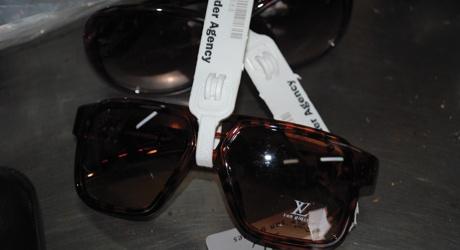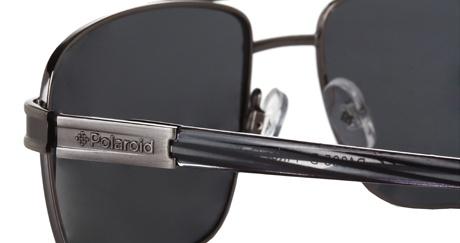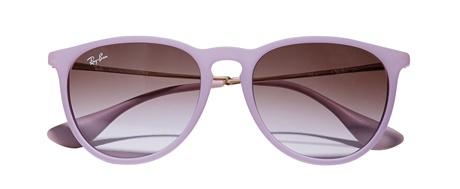Warning: how social media is a danger to brands
Marketing Week investigates a £10bn online counterfeit industry that is exploiting social media to pose as brands and finds out what the authorities and companies are doing to fight back.
Picture credit (above): Home Office
A Marketing Week investigation has found that a range of brands, including Ugg Australia, Mulberry, Ray-Ban and Louis Vuitton are being targeted by unauthorised websites that use social media to promote their claims of selling luxury goods. We uncovered a number of sites not listed in these brands’ published networks of resellers that use links and paid-for advertising space on platforms such as Facebook, Twitter and Pinterest to bring in web traffic, using brands’ photographs, logos and trademarked words.
Social networks are the biggest cause of consumer complaints about fake products and January is the most prolific month of the year for reports being made, according to the Intellectual Property Office.
Brand protection company MarkMonitor says online counterfeiting is worth about £10bn annually in the UK. But research among marketers published last year[1] by Marketing Week and NetNames showed that a quarter have no process for monitoring or enforcing anti-counterfeiting action.
This ‘social counterfeiting’ is a huge problem that brands, especially luxury names, cannot ignore, according to Chrissie Florczyk, director-general (designate) at the Anti-Counterfeiting Group (ACG). She says: “It has grown exponentially in the past year. This is the first time our members have felt strongly enough to say we need to do something now. It has hit the tipping point and we can’t keep turning a blind eye to it.”
Confirmed counterfeit sites include saleuggs.salesbootsoutlet.com, which is registered under an address in China but uses Ugg Australia branding to sell sheepskin boots. Another site, purporting to sell Mulberry goods, was acknowledged by the luxury fashion brand to be a counterfeit site that it was trying to shut down.
Technology changes so fast that legislation can’t keep up with the advances and criminals are one step ahead of law enforcement
Marketing Week has succeeded in closing down one website, storeslv.com, after reporting it to internet domain name overseer ICANN for having inaccurate registration data. The site, which was registered in China, was purportedly selling Louis Vuitton-branded merchandise while using Facebook as an advertising platform, despite the French fashion brand selling its goods only via its own websites and stores. LVMH, which owns Louis Vuitton and many other luxury brands, has around 60 people working on brand protection, targeting the factories that make fake products.
While there are numerous online outlets for counterfeiters to sell their wares, including search engines, marketplaces and sites on the open web, the problem of counterfeiting on social networks has recently become much more acute.
Both the ACG, which represents 160 brands, and Trading Standards, which is responsible for enforcing anti-counterfeiting legislation, ran parallel operations in the run-up to Christmas to report and take down social media accounts and ads suspected of promoting counterfeit goods.
However, many brands could struggle to take effective anti-counterfeiting measures themselves, since a social media account can be abandoned by a counterfeiter and a new one set up at a moment’s notice. A case study by brand protection agency NetNames of a pharmaceutical client reveals as many as 4,500 suspect accounts or groups in that sector have been identified on Facebook and Twitter over a six-month period. The ACG has identified at least 1,300 unauthorised listings of various types of products on Facebook during its operation (see box, below[2]).
Lack of awareness
Many marketers may not be aware of the scale of the problem their brands face, according to research by NetNames. More than half of the marketers surveyed rate their own knowledge of brand protection issues as average or worse.
The research also found an even split between companies where the responsibility for monitoring infringements falls to marketers and those where legal teams take the lead. But Chris Knight, co-founder of Swiss Eyewear Group and former marketing director of Polaroid eyewear, says that he has seen little evidence of brands employing specialists in the area and that awareness is generally lacking at executive levels.
However, businesses including Deckers, which owns Ugg Australia, Beats by Dre and pharmaceutical giant Roche are looking to hire brand protection personnel with legal or investigative backgrounds. Roche is looking specifically for a person who has an understanding of social media and online promotional practices. Knight warns that marketers choosing to turn a blind eye to counterfeiting are seriously dangering consumers’ perceptions of their brand. “The overall desirability of the brand goes way down if you see copies everywhere,” he says (see viewpoint, below[3]).
Trading Standards joint-lead officer for ecrime Paul Thompson says that social networks are particularly difficult environments for brands and enforcement bodies to monitor for counterfeiting.
“Technology changes so fast that legislation is not keeping up with the technological advances, and criminals are one step ahead of law enforcement. That’s the battle we have,” he says.
Thompson adds that Trading Standards relies mostly on complaints from members of the public who have bought a counterfeit product. “The main social media complaints we receive are from consumers who are unknowingly part of a group that’s been set up to sell counterfeit goods via Facebook. There are plenty of examples if you go onto Facebook and key in ‘buy and sell’.”

Source: Home Office[4]
Marketing Week found a site using Facebook to sell Louis Vuitton goods without authorisation. It has since been shut down
False or fraudulent content is against Facebook’s guidelines and it says on its legal pages that it will remove content that violates another party’s intellectual property rights. A Facebook spokesperson says: “Facebook takes intellectual property seriously. When a rights owner makes us aware of counterfeit goods being sold on Facebook, we take appropriate action.”
Counterfeiters also appear to be very active on Twitter and Pinterest. A search for ‘Louis Vuitton’ on Twitter shows that the majority of tweets referring to the brand include a link to a third-party website claiming to sell its products. On Pinterest, the same search returns images of apparently genuine Louis Vuitton handbags but clicking through to the linked website again leads to a URL outside the brand’s own web domain.
Adding terms such as ‘cheap’ or ‘discount’ to a search for a brand name on social media sites often brings up even more examples.
Twitter did not respond to Marketing Week’s findings in detail but did provide a link to its general policy on counterfeiting, which states that “Twitter prohibits the sale, or promotion of sale, of counterfeit goods on the Twitter platform”. The company also points out that it has online portals where users can report violations.
Trading Standards’ Thompson says: “There are less complaints through Twitter [than on Facebook]. It’s not a major issue, as far as I see it.”
Pinterest, which did not comment on the findings, has barely crossed the radar of investigators, Thompson admits. At present, their work is concentrated on Facebook, including a campaign, run in December, where Warrington and Halton Trading Standards collaborated with the company to remove 21 accounts suspected of advertising counterfeit goods, including fake GHD hair straighteners, Ugg boots and illegal tobacco.
This is the first time our members have felt strongly enough to do something. It’s hit a tipping point and we can’t turn a blind eye
Thompson, who is an enforcement officer in Warrington, says: “The reason we have taken this approach with Facebook specifically is that we know we have a problem on the site.”
He adds that Trading Standards has been in talks with the social network for 18 months, particularly about sharing user data when suspicions are raised, and intends to hold further talks in order to “iron out the creases” in 2014.
ACG’s Florczyk indicates that the group will similarly seek meetings with Facebook in the near future, to set out “the issues our members have as rights owners”. One key question concerns Facebook’s business model with regard to traders that sell or advertise goods on its website.
“That’s another area that we need to explore with them, because there are legal implications if you’re starting to take a cut of the proceeds of crime. At this stage we just don’t know,” she says. Facebook’s contention is that individuals and not platforms are responsible for any alleged criminal actions that take place online.
Facebook did not comment directly, however, on the ways in which counterfeiters were found to be using its advertising inventory. Of the social networks examined, only on Facebook were counterfeiters buying advertising space, in most cases using brands’ intellectual property – including photographs, logos and trademarked words – while linking to unofficial websites. This is forbidden by Facebook, which notifies advertisers “Ads and Sponsored Stories may not promote or facilitate the sale of counterfeit goods”.
It would also contravene the advertising code regulated by the Advertising Standards Authority. However, press officer Matt Wilson says that its self-regulatory mechanisms are only effective with advertisers that are likely to comply. “Where a company or individual is acting illegally we will take what action we can. But selling counterfeit goods is an issue that extends beyond our remit and enforcement powers,” he says.
“We regulate the advertising of legitimate businesses. Stopping bogus operators that act fraudulently and fleece people out of their money is often difficult and law enforcement bodies such as the police are better placed to take action. We do liaise with search engines and social networks to have problem ads removed and to place our own ads in and around a company’s search results as a means of highlighting the problem, raising awareness among consumers and warning them to avoid falling victim to misleading advertising.”
Difficult detection
According to Thompson at Trading Standards, as well as the difficulty of enforcing compliance, problems of detection are also created by the personalisation of Facebook ads, as different ads are shown to each user and are changed frequently. A user who has seen a suspected counterfeit ad must therefore be aware enough to take a screen shot for use as evidence before navigating away from the page.
Advertising space on social media was not included in a new initiative to avoid misplacement of ads online, announced by the industry-wide Digital Trading Standards Group (DTSG) in December. The group has no affiliation with Trading Standards but comprises the Association of Online Publishers, ISBA, the Institute of Practitioners in Advertising, the Internet Advertising Bureau and marketing bodies.
The DTSG’s UK Good Practice Principles set out guidelines that brands, media owners and agencies should observe in order to avoid ads and website content being matched inappropriately. Advertising providers will have their own policies audited under the scheme, with those approved receiving a ‘seal of compliance’. According to IPA head of digital Nigel Gwillam, social networks’ advertising inventory is not covered by the principles because the priority for the DTSG negotiations was to govern the “open traded environment” on the wider internet.

Polaroid suffers from counterfeit activity and its former marketing chief says there is a general lack of awareness of the problem at a senior level
He concedes there are concerns with ad misplacement on social media, but that “with a ‘walled garden’ environment you know where to go” as an advertiser to have those problems resolved, referring to the social networks. He argues that the issue of counterfeiters buying advertising space is a slightly different issue, although legitimate advertisers may object to their ads appearing alongside counterfeit traders’ ads.
In a separate campaign, the IPA has worked alongside other creative industry bodies and the UK’s Police Intellectual Property Crime Unit to cut off revenues to counterfeiters. The bodies sought to prevent reputable companies’ advertising from being placed on websites that make unauthorised use of copyright content.
The wider internet may still pose a more challenging counterfeiting threat for brands to combat than social media, given how large and unregulated it is. However, it is clear that the use of social networks to promote the trade of illicit goods has seen rapid growth. According to Thompson, identifying the people behind a suspect account is problematic.
“If someone is using it as a personal account, it is easy for us to identify them by looking at open source information that they have put online, but if it is an account where the privacy settings are closed, that’s more difficult.”
It is for this reason that both brands and law enforcement authorities will be seeking further collaboration with social networks in the coming months, to ensure that counterfeiters cannot stay hidden in the shadows.
Fake Ray-Bans from facebook

To assess the quality of products sold via unauthorised sites, Marketing Week ordered a pair of sunglasses from a website featured in a display ad on Facebook. The seller, newsjps.com, claims that these are Ray-Ban Aviators; however the company is not named on Ray-Ban’s own site as an authorised reseller. The glasses cost £12.50, whereas the normal price is £100 or more.
The glasses arrived in a roughly cut cardboard box with Chinese postage labels, including a customs declaration giving the value of the package at only $5. The product lacks many of the markings typical of genuine Ray-Ban aviators (a genuine pair is pictured below). For example, no product number is stamped on the frame of the glasses, the gold Ray-Ban stamp on the pouch has patches of paint missing and the stitching on the pouch – made of plastic – is frayed at the ends.
Luxottica, the Italian holding company that owns the Ray-Ban brand, did not comment on Marketing Week’s findings nor did it confirm whether the sunglasses were genuine. However, the website from which they were purchased ceased to be a registered domain name shortly after Marketing Week contacted Luxottica.
Fake pharma
A 2011 study by the World Health Organisation found that 64 per cent of anti-malarial drugs in Nigeria were fake, and The Economist has described the 21st century as ‘a golden age for bad drugs’. The fact that manufacturing and packaging are often done in different places, borders are poorly policed and, in some developing countries, people are desperate for medicines, is helping the fake drugs industry to thrive.
And it seems that counterfeit drugs are being sold via social media prolifically. Brand protection company NetNames monitors Facebook and Twitter for one pharmaceutical firm and identified more than 4,500 suspicious pages and profiles over a six-month period. All had links to external internet content where counterfeit goods could be ordered. The content was mainly hosted on rogue websites using legitimate brand names within the domain name to improve search rankings and give the impression they are official sites. Fake items were also on sale from unlicensed internet pharmacies.
False fashion
NetNames monitors four social media sites for a high street fashion brand. Over six months, about 1,000 pages and profiles were identified as suspicious. Some purported to be the brand owner, while others claimed to be a licensed distributor or were otherwise advertising illegitimate products for sale. Of the pages identified as suspicious, 60 per cent contained clear unauthorised use of the brand or links to content where fake goods could be ordered.
Chrissie Florczyk, designate director-general of the Anti-Counterfeiting Group, says efforts are being made to engage social networks and get more co-operation from them to stop the practice.
“There are processes in place to take down these listings. We look forward to working with these platforms to simplify some of those processes. Some are straightforward – the click of a mouse – but others require capturing data and copying it into a document.”
Viewpoint
Chris Knight
Co-founder Swiss Eyewear Group
(former marketing director, Polaroid Eyewear)
There’s a lot of counterfeiting in eyewear, and it’s not just high-end brands such as Chanel. Everyone down through Polaroid and even local brands gets counterfeited. Often, a factory or sub-contractor sees a product going out in volume and copies models and the branding. It’s easy to do and they make that product available to customers who operate in the same regions.
Eyewear companies are not as active in anti-counterfeiting as Adidas and Nike, for example. There has been talk that Luxottica might start something because it owns Ray-Ban and Oakley. At the moment everybody operates individually, such as by trying to raid factories in China and stop fakes coming into a market.
I haven’t seen that much counterfeiting on social media but I am sure that it is used by counterfeit sites to promote themselves. I have seen it on B2B sites – there are people on LinkedIn offering counterfeit products, for example.
At the highest level [within a brand] there isn’t much awareness of what is happening. Some of the younger employees are probably more switched on to what is going on but at an executive level they don’t see it as much and certainly aren’t aware of what they can do. If there were an eyewear anti-counterfeiting group, you could create lists of known factories. I think brands could share more information.
I have not heard of anyone employing specialist brand protection people in eyewear but I think it is something they should be doing. If there were trademark specialists they would probably work on the registration and maintenance of them, rather than protection.
References
- ^ research among marketers published last year (www.marketingweek.co.uk)
- ^ see box, below (www.marketingweek.co.uk)
- ^ see viewpoint, below (www.marketingweek.co.uk)
- ^ Home Office (www.marketingweek.co.uk)









